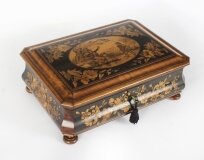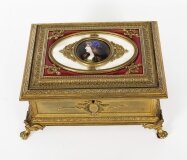Tea caddy
is a box, jar, canister, or other receptacle used to store tea. The word is believed to be derived from catty, the Chinese pound. The earliest examples that came to Europe were of Chinese porcelain, and approximated in shape to the ginger-jar. They had lids or stoppers likewise of china, and were most frequently blue and white. Until about 1800 they were called tea canisters rather than caddies.
![]()
Earlier tea caddies were made of either porcelain or faience. Later designs had more variety in materials and designs. Wood, pewter,brass, copper and even silver were employed, but in the end the material most frequently used was wood, and there still survive vast numbers of Georgian box-shaped caddies.. These were often mounted in brass and delicately inlaid. Many examples were made in Holland, principally of the earthenware of Delft. There were also many English factories producing high quality goods.![]()
As the use of the jar waned and the box increased, the provision of different receptacles for green and black tea was abandoned, and the wooden caddy, with a lid and a lock, was made with two and often three divisions, the centre portion being reserved for sugar.
The larger varieties were known as tea chests. As tea grew cheaper there was less concern with the appearance of caddies, and as a result they fell out of use. The use of "tea caddy" instead of "biscuit tin" fell out of use in the early 1900s.
Gonçalo Alves is a hardwood (from the Portuguese name, Gonçalo Alves). It is sometimes referred to as tigerwood — a name that underscore the wood’s often dramatic, contrasting color scheme.
While the sapwood is very light in color, the heartwood is a sombre brown, with dark streaks that give it a unique look. The wood’s color deepens with exposure and age and even the plainer-looking wood has a natural luster.
Two species are usually listed as sources for gonçalo alves: Astronium fraxinifolium and Astronium graveolens, although other species in the genus may yield similar wood; the amount of striping that is present may vary.
In the high tropical forests of Central and South America, well-drained soils furnish nutrients for a variety of dense, durable hardwoods sought for maritime use, heavyconstruction, and furniture. The Spanish began harvesting in Latin American forests in the early 1500s to provide timber for boatbuilding and repair. By the early 1900s, however, steel ships had replaced wooden ones, and the interest in tropical forests by both Europeans and Americans shifted to appearance-grade woods for furniture.
Although history fails to provide us with a shopping list of species from either harvest period, it's probable that the wood we know today as goncalo alves has always been sought. That's because goncalo alves, considered one of the most beautiful of tropical woods, has a tough reputation, too. Strong and durable, it's used for construction in its homeland and secondarily for fine furniture. Woodworkers elsewhere treasure the wood for decorative items and veneer accents.




























